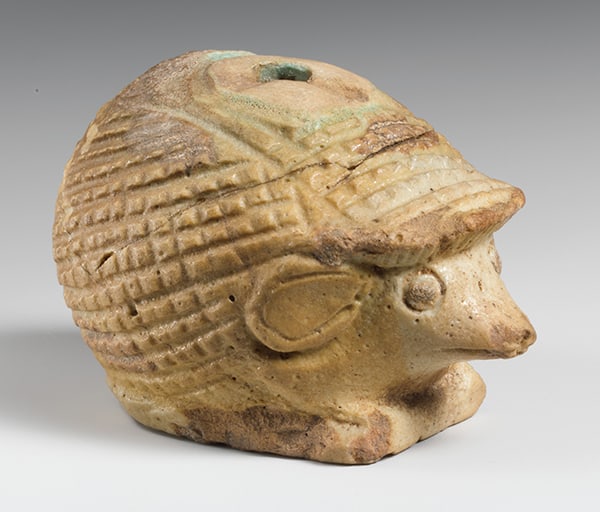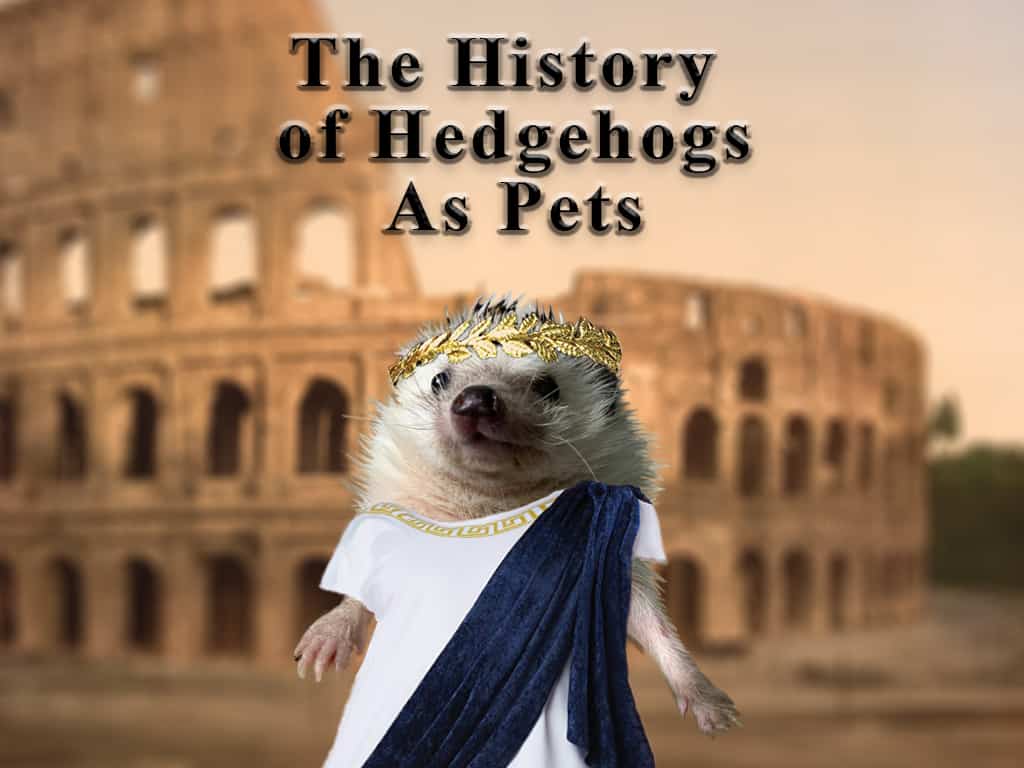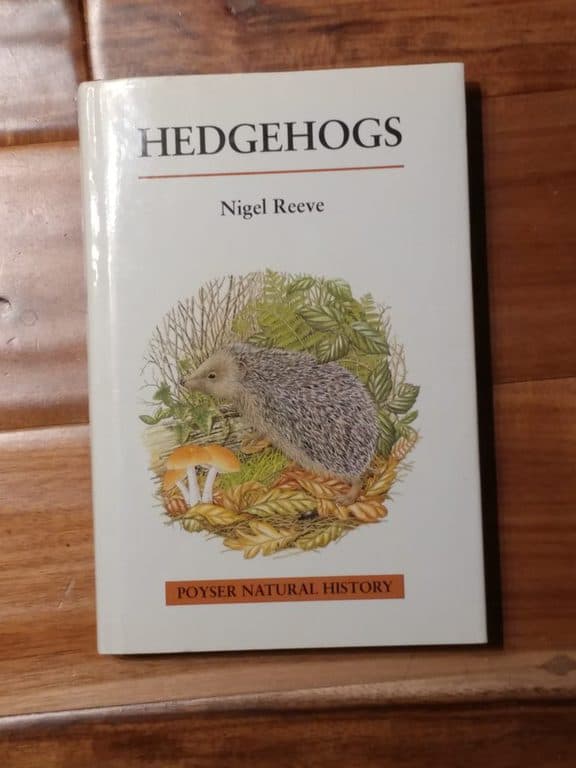In order to explore the history of hedgehogs as pets, we must look back to around the 4th century BC. That's when the Romans first domesticated relatives of Algerian hedgehogs. [a] Imagine our horror to learn that there are recipes dating back to 6000 BC that feature roasted hedgehog as the main ingredient! How gruesome! We can't imagine someone eating such an adorable creature.
While it may be surprising, some people believe hedgehogs go back as far as the late Cretaceous period. Although we're not entirely convinced that the whole prehistoric account is true, there is substantiated evidence that goes back to at least the 7th century BC. While it may make no difference on domesticated hedgehogs today, it's still interesting to take a peek at their history.
Acknowledgement: We'd like to express our gratitude to Jenna Perlick for allowing us to use her picture of Ollie that we modified with Roman garments for this article. She's the proud owner of Prickle Pack Hedgehogs. If you're located near Chicagoland, she has some amazing hedgehogs and tenrecs.
AFFILIATE DISCLOSURE: Heavenly Hedgies is an Amazon Associate. We have partnered with them and other reputable merchants when they sell something that we feel will benefit our readers. By purchasing through our links, we may earn a small commission on sales, that helps us continue to provide informative and educational information for hedgie lovers. And the best part is that there is no additional cost to you. Thank you for being a loyal and supportive reader here at Heavenly Hedgies.
Anyone that is interested in the natural history aspect of hedgehogs over the ages won't go wrong by getting this book by Nigel Reeve. It's no longer being printed but there are excellent used editions that aren't all that expensive. We will forewarn you that the writing is very technical, just in case this type of thing bores you. This is a picture of our copy, which has been such a blessing to us in expanding our knowledge of hedgehog. In fact, some of the information we will be sharing was found in this very book:
Conflicting Theories on The Genetic History Of African Pygmy Hedgehogs
Many believe African Pygmy hedgehogs (APH) are derived from mating North African hedgehog (Atelerix algirus) with four-toed hedgehog (Atelerix albiventris) [b]. If the four-toed hedgehog doesn't sound familiar, maybe you're familiar with a different name – the white-bellied hedgehog. You can learn more about Algerian Black hedgehogs here. African pygmy hedgehogs are the most commonly domesticated hedgie, but they aren't the only ones. Egyptian long-eared (Hemiechinus auritus) and Indian long-eared (Hemiechinus collaris) hedgehogs are less common hedgehogs kept as pets.
So little is known about the true genetic origins of African Pygmy hedgehogs. Are they really a hybrid of the North African and Algerian hedgehogs? While many have perpetuated that belief, you can read a compelling and thought-provoking challenge to that theory: The African pygmy hedgehog: hybrid or not? We encourage you to give it a read and make your own determination. Without DNA history, both theories are speculative.
Ancient History Of Hedgehogs Over Time
Hedgehogs Used for Textiles
As we previously mentioned, we can find reference to the Romans domesticating and commercializing hedgehogs as early as the 4th century BC. In fact, Romans used hedgehog fur to raise the nap on textiles such as wool [c]. The practice was so profitable that the Roman senate wrote laws to monopolize the trade and capitalize on this commodity [d].
Hedgehog-Shaped Jewelry
In Mongolia, a pendant adorned with a chunky hedgehog (circa 3rd century BC) was found. And somewhere around 5th century BC in China, yielded a ring-shaped buckle with two hedgehogs confronting each other. [e] Apparently the hedgehog was just as impressive back then as it is today.
Hedgehog Symbology in Art
From as far back as 5000 BC, hedgehogs have been the subject of symbology in a variety of art forms. For example, a terracotta hedgehog head (dating back to 5000-4000 BC) was found in Yugoslavia. The hedgehog's nocturnal habits led to superstitious ties to lunar cycles. And their hibernation habits mystically tied them to rebirth and rejuvenation. During the neolithic period, there were those that worshiped a “Great Goddess” and they symbolized her uterus by the hedgehog. [f]


During the Renaissance era, a painter Andrea Mantegna, produced an allegorical painting (Parnassus circa 1427) representing Apollo and Venus. Looking closely, there is a hedgehog symbolically located in the foreground. In the book The Roman Stamp: Frame and Facade in Some Forms of Neo-Classicism by Robert Martin Adams, the author places symbolic significance to the hedgehog's placement. This placement was significant due to the hedgehog being “famous for guile and spite” and their ability to roll up into an injurious spikey ball. Many paintings came out of the Renaissance era filled with complex symbology.
Hedgehogs in Food
As we mentioned at the beginning of this historical trail, there is documented culinary history of hedgehogs. Even Britain (that now reveres and protects hedgehogs), considered them a delicacy commonly served during feasts around 1425. Even the 18th century citizens of the Balearic Islands ate the four-toed hedgehog (Atelerix albiventris). Many recipes exist over the ages instructing how to cook hedgehog. It's hard for us to imagine that anyone could bring themselves to eat an animal as endearing as the hedgehog, yet history shows that it happened.
Other Historical Uses of Hedgehogs
In Adam's book (pictured earlier), the author cites that various hedgehog body parts were used as medicine. Some of the ailments treated with them were: colic, balding, boils, leprosy, urinary stones, and for enhancement of night vision. Unsurprisingly, hedgehogs were also believed to foretell the weather. Their habits, use, and likeness deeply entwine with history. [pp 250-251]
Hedgehogs were muses for many notorious writers. For example, Geoffrey of Monmouth (1100-1155), William Shakespeare (1564-1616), Lewis Caroll (1865) all spoke of hedgehogs in several famous literary works. In 1905, Beatrix Potter cast the hedgehog in a favorable and whimsical light in her book The Tale of Mrs. Tiggy-winkle. This novel turned hedgehogs into a creature to be loved and admired.
How Did Hedgehogs Become Popular As Pets?
The short answer is that although there were occasional minor hedgehog imports prior to 1991, one mass import turned the tables. An importer named Richard Stubbs, imported 2,000 hedgehogs from Africa and sold them to a variety of pet shop owners. The hedgehog quickly became a “fad pet”, and a demand for them ensued. This demand increased imports from 1991-1994. That is, until legislation due to foot and mouth disease stopped the imports from afflicted countries. However, the bigger picture is detailed below.
The tales circulating the internet tout how Richard A. Stubbs initially imported 2,000 hedgehogs into the United States that he purchased for $0.50 each in Lagos, Nigeria. As legend goes, the hedgehogs were well received and “Stubbs exported around 50,000 hedgehogs while living in Lagos“. This trade is reported to have occurred from 1991-1994, at which time it ended due to a 90 day quarantine placed on the imports. Apparently Hoof and Mouth Disease was being carried by the hedgehogs.
Historical Accounts of Hedgehogs As Pets are Questionable
Aspects of this tale may be true. Some of them are inaccurate. There was definitely a Richard Stubbs that owned an import business. But it mainly focused on reptiles. This Ohio-based import company was so entrenched in reptile imports that in August 1991 he was being investigated for illegaly importing endangered dwarf crocodiles from Lagos. The June 1992 edition of the Miami New Times described Strubbs as “a shadowy Togo-based reptile importer whom Miami traders variously describe as ‘a nice guy' and ‘the most greediest human alive.' The report focused on the illegal smuggling of giant snails into the US with a shipment of reptiles by Stubbs.
It was also reported that Stubbs “abandoned 179 lizards, 40 pythons, and nearly 1000 tarantulas, centipedes, and scorpions in a warehouse near suburban Westerville, Ohio” in November 1991. His indictment for the dwarf crocodiles was handed down in August 1992, which he was sentenced to 12 months in federal prison. Our trail ran cold on whether he actually served any time for his crimes.
Fact Versus Fiction
Given Stubbs' legal issues during the importation period of hedgehogs, it's highly suspect that he imported 50,000 of them into the United States. It's very possible that he may have gotten the ball rolling with the initial 2,000, since he seems like the opportunistic type. One look at these unique creatures is enough to create demand. It's entirely possible that he imported more, but we don't believe that it's likely.
Our goal in presenting these facts about Stubbs is to help our readers learn to question information. Become researchers so that you can know the truth for yourselves. Much misinformation has circulated about hedgehogs. Much of it is embroiled with tradition rather than evidence. In our article, Hedgehog Care Facts That Are Wrong, we try to open our readers eyes to some of the common misconceptions about hedgehogs.
9 CFR 92 and It's Impact on Hedgehogs as Pets
As we mentioned, importation of hedgehogs came to almost a screeching halt due to hoof and mouth disease (HMD). The Animal and Plant Health Inspection Service under the Secretary of Agriculture amended 9 CFR 92 on November 29, 1995 as follows:
Sec. 92.701 Prohibitions.
(a) No person may import a hedgehog or tenrec into the United States from any country designated in Sec. 94.1 of this chapter as a country where foot-and-mouth disease exists.
And further…
Sec. 92.705 Health certificate.
(a) No person may import a hedgehog or tenrec into the United States unless it is accompanied by a health certificate either issued by a full-time salaried veterinary officer of the national government of the exporting country or issued by a veterinarian authorized or accredited by the national government of the exporting country and endorsed by a full-time salaried veterinary officer of the national government of that country. The health certificate must contain the names and street addresses of the consignor and consignee and must state: [[Page 55183]]
(1) That the hedgehog or tenrec originated in a country that has been recognized as free of foot-and-mouth disease by the USDA;
(2) That the hedgehog or tenrec has never been in a country where foot-and-mouth disease exists;
(3) That the hedgehog or tenrec has not been commingled with any other hedgehog or tenrec that originated in or has ever been in a country where foot-and-mouth disease exists;
(4) That the hedgehog or tenrec was inspected by the individual issuing the health certificate and was found free of any ectoparasites not more than 72 hours before being loaded on the means of conveyance which transported the animal to the United States;
(5) That all body surfaces of the hedgehog or tenrec were treated for ectoparasites under the supervision of the veterinarian issuing the health certificate at least 3 days but not more than 14 days before being loaded on the means of conveyance that transported the animal to the United States;
(6) That the pesticide and the concentration used would kill the types of ectoparasites that may infest the animal to be imported;
(7) That the hedgehog or tenrec, after being treated for ectoparasites in accordance with paragraphs (a)(5) and (a)(6) of this section, had physical contact only with, or shared a pen or bedding materials only with, treated hedgehogs or tenrecs in the same shipment to the United States; and
(8) The name and concentration of the pesticide used to treat the hedgehog or tenrec.
This legislation made it very difficult to import hedgehogs! But by the time it was enacted, hedgehogs had already become a fad pet. Being difficult to import, and the hedgehogs being in high demand, interbreeding within family lines began to occur. Many believe that interbreeding is what produced Wobbly Hedgehog Syndrome and the propensity toward cancer within this precious animal. In fact, our first hedgehog (1999) died within a few months of having her. At the time, the vet believed her death was due to an undelivered fetus. Given the lack of veterinary knowledge back then and what we know now, it's more likely that she had uterine cancer. Our second hedgehog died of confirmed WHS.
Will The History of Hedgehogs Repeat Itself?

Most of this article has dealt with history of the African Pygmy hedgehog. We have only briefly mentioned Egyptian long-eared and Indian long-eared hedgehogs as uncommon hedgehog pets. From observation, there has been an increasing number of these hedgehog species gaining popularity on the internet. Our concern is that breeders retain pure bloodlines in these breeds so that history doesn't repeat itself. If you haven't read it already, we encourage you to read The Need For Ethical Hedgehog Breeders. It would be a shame for another species to suffer the same outcome as many African pygmies.
Regardless of historically how they got here, it's safe to say that hedgehogs have become a cherished pet world-wide. They are the type of pet that many people have adopted into their homes. The future of hedgehogs is that they're here to stay!


